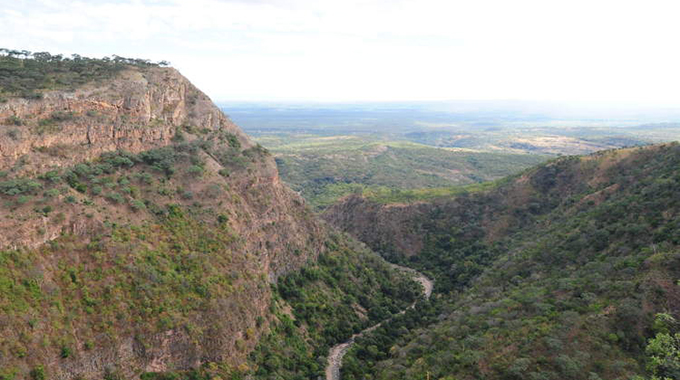Chizarira . . . craggy and far from the madding crowd

Isdore Guvamombe
Assistant Editor
MOUNTAINS tower above everything else but from their belly explodes an intricate network of valleys, rivers and rivulets from which wildlife trickle for their life-saving water, of course forever stalked by predators.
Chizarira National Park is arguably one of the most scenic wildlife sanctuaries in Zimbabwe and the largest too, covering 2 000 square km. Defiantly superimposing itself like a giant colossus south of the Zambezi Valley escarpment, about 80km south-east of Binga, on the southern shore of Lake Kariba, Chizarira is not a place for the faint-hearted.
It is the place for the hard and discerning tourist, one who enjoys jungle challenges, like mountain hiking, trekking and bush camping. If you think you are made of sterner stuff, try it.
Bounded in the north, west and east by Binga, Gokwe and Manjolo communal lands and the Chirisa Safari Area to the south, Chizarira is a Shona corruption of the Tonga word Sijalila, which means enclosure and in this case, a wildlife enclosure.
Closed off by the undulating plateau of the Zambezi Escarpment, Chizarira is endowed with an amazing species of flora, among them the rarest of tree species found nowhere else in Zimbabwe.
Among this are high-veld Brachystegia species in the north to lowland mopane scrub and woodland in the south.
Acacia albida woodlands along the southern boundary to the riverbank of the park supports a wide range of plant species including Mishimi Teeta, a local medicinal plant used to cure a number of diseases.
Significant populations of elephant, cheetah, zebra, buffalo, lion and leopard are found in the park.
There are also many species of smaller game, including the klipspringer, famous for its ability to inhabit rocky outcrops; sable, common waterbuck, kudu, bushbuck, and steenbok.
The black rhinos that used to trudge the length and breadth of the park were relocated to intensive protection zones to thwart poaching that threatened their extinction.
Chizarira offers an abundance of unique bird life where more than 200 bird species have been recorded.
The birds of the area include Livingstone flycatcher, the African broadbill, Emerald cuckoo, Yellow spotted nicator, racket-tailed roller, Whyte’s barbet, miombo wren-warbler, white-breasted sunbird, black-eared seed eater and the rare and elusive Angola Pitta.
The best birding spots are in the grassy valleys and riverine forests.
There are three main routes by road into Chizarira National Park. From Victoria Falls one can take the Bulawayo Road and turn left towards Kamativi at Cross Dete.
From Kamativi one follows the Binga Road and turn right along the Siabuwa Road at the 133km peg.
Follow this dust road and turn right at the 48km mark where you meet Chizarira National Park signage.
This undulating road also goes for 20km to the park headquarters at Manzituba. A four-wheel-drive vehicle is recommended.

Chizarira is endowed with an amazing species of flora
Alternatively, one can use the Harare-Bulawayo route by driving towards Gokwe. At Gokwe take the Binga Road for 120km where you will get to a T-junction with a signpost indicating Binga to the left.
Drive for 47km along this dust road until you see the Chizarira National Park sign.
Turn left and proceed for 20km to the Park headquarters. Visitors coming from Bulawayo can use the Victoria Falls Road and the turn off at Gwayi River on the Lubumbi Road.
Although there are no lodges inside the park, except camp-sites, the area neighbouring the park has developed innumerable accommodation facilities and exclusive bush camps.
Inside the park accommodation options include Mucheni Gorge Camp, Mucheni View Camp, Busi Camp, Kaswiswi Camp I and II, Mabola Camp and The Platform.
Although it is open all-year round, the rainy season renders some areas inaccessible, and the best time to visit is June to September.









Comments